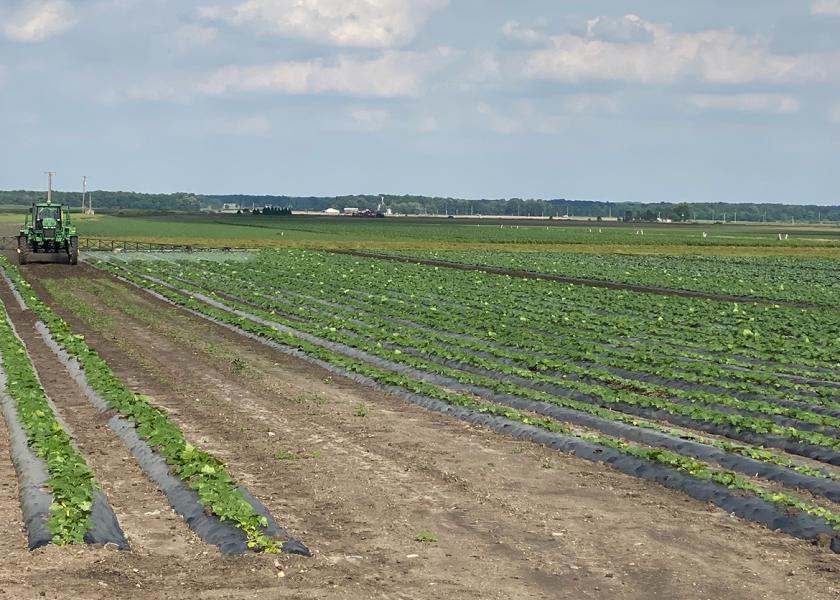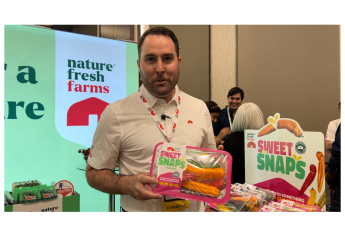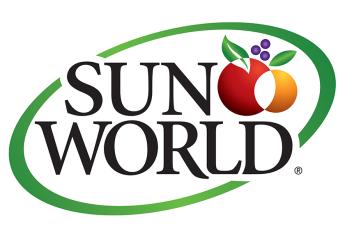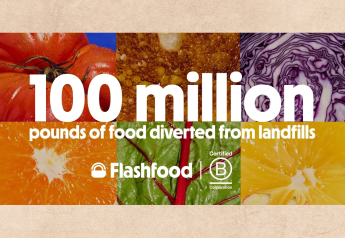Ohio, ‘a good place to be’ for produce

The fields of Ohio are a smorgasbord of more than 200 types of produce, ranging from grapes to peaches and apples on the fruit side, to tomatoes, sweet corn, squash and pumpkins in the vegetable family. The top crops are corn and soybeans.
The state has 14.9 million acres of farmland, according to the USDA. Food and agriculture make up the top industry, with 44% of the state considered prime farmland. In Ohio, there are around 80,000 farms, 99% of them owned by families, most of them in the Northwest section of the state.
Diversity on local farms
Buurma Farms grows a variety of vegetables, including radish and beets, at its farms in Willard, Ohio, and Gregory, Michigan. About half of its produce comes from each state.
"Business is very diversified," says President Chadd Buurma. "There's not one product that sticks out. We're handling 30 different items, [so] our customers can come to us and it's pretty easy to fill a truck when they have so many commodities to choose from. It's one-stop shopping and it's a niche that helps us to move our product."
This year, the weather has cooperated and, although Buurma was late getting seeds planted, Chadd Buurma said, everything is now on schedule for harvesting.
Buurma sells most of its produce within a 400-mile radius of Ohio but does cover most of the East Coast.
D.R. Walcher Farms in North Fairfield specializes in bell peppers, cucumbers, summer squash, eggplant, winter squashes and fall ornamentals.
“We size, grade and market the produce,” says Owner Ken Holthouse. Around 40% goes to large grocery chains, either directly or through wholesale brokers; another 40% is for foodservice, mostly to distributors who slice and dice it; and the remaining 20% goes to the commission market, which sells to restaurants and mom-and-pop stores.
One-third to half of the produce stays in the Midwest, he says, especially Ohio, Michigan and Indiana, because “the locally grown program is pretty big,” but it does go further, east of the Mississippi.
In 2012, D.R. Walcher Farms’ packing plant became PrimusGFS-certified, and here, the company packages produce in bags. “It’s not ready-to-eat, but it’s washed,” said Holthouse, who does the same through the other side of his business, Holthouse Farms, in Willard.
The bagging side of business is growing, he says. “Chain stores have encouraged more self-checkouts in the past few years and you want your customer to be able to scan something rather than type in a [price look-up] code.” Because of the bags, the labor required and because fewer items fit in a box, Holthouse marks up these items a little.
The farm packs and ships vegetables from its own fields, as well as from other local contracted growers in six states. “They bring it to me, and we pack and grade and size and market it and take a commission,” Holthouse says. Then, the produce is all sent out under the D.R. Walcher name. “We have checked them for supply-chain integrity. We don’t want anyone who doesn’t [conform] to our standards.”
Challenges: costs and labor
All input costs remain a huge challenge for Buurma, including fuel and packaging.
“Those costs are up and we’ve got to try and show a profit, so we have to pass along as much of that cost as we can without scaring people from vegetables,” Buurma said. “It’s a fine line to keep the price competitive where the stores can still put it on their shelves and have the customer still want to buy it. This year will be trickier than any we’ve seen in a long time.”
For labor, Buurma Farms uses the temporary worker H-2A visa program, and while the wages are close to double, the quality of the workers is high. “Had we not taken part in it, I don’t know that we’d have had enough workers to harvest everything,” Buurma said.
Holthouse agrees that the H-2A workers “get more done in less time, even though it’s expensive.” At the beginning of the season, he tells employees he’ll weed out the bottom 10% of the workforce, who won’t come back the next year. “It’s a good idea to advertise that at the beginning,” he says.
Retailing success
Buurma Farms sells to retail, mostly, followed by foodservice accounts and wholesalers. And while the produce goes east of the Mississippi River, a lot stays local because local produce sells well.
“Retail customers want that home-grown appeal,” says Buurma, who works with the retailers to provide items such as photographs for point-of-sale displays so they can promote the local aspect of the products.
He also regularly invites retailers to visit his farm so they can have a personal connection to it. “They can see some struggles we might have and it’s a different perspective. We invite customers on-site [and] they learn about us, and we learn about them. It takes a lot of time, a lot of effort, to build a relationship like that, but it’s the best way to sell our product,” Buurma explains.
“A few years ago, retailers started focusing more on locally grown because there was a move afoot to reduce food miles,” said Holthouse, and this certainly makes his life easier. So long as he has quality produce, he says, “retailers will stay loyal.”
Local Ohio produce sells really well at the two Produce Place Markets, in Lyndhurst and Willoughby Hills, Ohio, starting in late May/early June and running through early November, says Owner-Operator-Manager Chase Teriaca.
During the growing season, he goes to Amish auctions three or four times a week and buys produce for the stores. The offerings are diverse but most common are sweet corn, zucchini and yellow squash, as well as apples in the fall.
He promotes these local farmers as much as he can in-store, by leaving the tags on boxes and incorporating the farm logos into signage. This way, he says, “people know where it’s coming from and they can look up the farms themselves or even drive down there. I want to promote farmers in general and Ohio farmers specifically.”
Since COVID-19 began, customers more than ever want to know where their food is coming from, Teriaca points out, “and the closer the better — the fewer trucks it has been on, the fewer hands it has touched.”
Next up, Teriaca’s tackling the company’s website with a refresh, and plans to include farmer logos and their stories so customers can learn about all the farmers he works with.
Distribution to retail, wholesale, schools
DNO Produce is a wholesale company in Columbus, Ohio, that brokers fresh produce nationwide and has an in-house distribution radius of 400 miles.
Business mostly focuses on foodservice and, within that, really specializes in schools. Typically, DNO supplies other distributors with produce who take it the last mile.
Most of DNO’s Ohio produce goes to the retail market, and less goes to restaurants that feature local Ohio product. Overall, about 10% of DNO’s produce comes from Ohio, but during the summer months, that jumps to 35%. Most of that produce is sold in bulk, says Alex DiNovo, president and chief operating officer.
He likes to keep the produce in-state as much as possible, which “is like compound interest,” he says. “I’m keeping people employed and then sending [produce] to an Ohio store or school, and those people are consuming local produce.”
Processing is a big part of his business, though only around 15% of Ohio produce is processed. “Convenience is a big part for the consumer and that’s only going to grow,” says DiNovo. “A lot of people don’t even know how to cook, so having something ready to go helps from a convenience standpoint but also from a cooking standpoint if it has instructions on it. That’s not going away any time soon.”
Convenience is also helpful for the foodservice and restaurant markets, he says, since both are challenged with labor shortages, so don’t have the time to prepare produce themselves.
Like the farmers, DiNovo is struggling with pricing on everything from plastic to corrugate to freight. “It’s been tough to keep our margin rate up with the pace of inflation,” he says. “We’ve raised our prices in line with inflation, but can you raise them enough?”
Despite the challenges, DiNovo thinks fresh produce will remain popular. “There are a lot of people already talking about food being medicine, and if so, produce is the best drug. We’re all-natural, grown in the dirt, we’re good for you and healthy; we’re not refined or processed. It’s a good place to be for the industry.”







